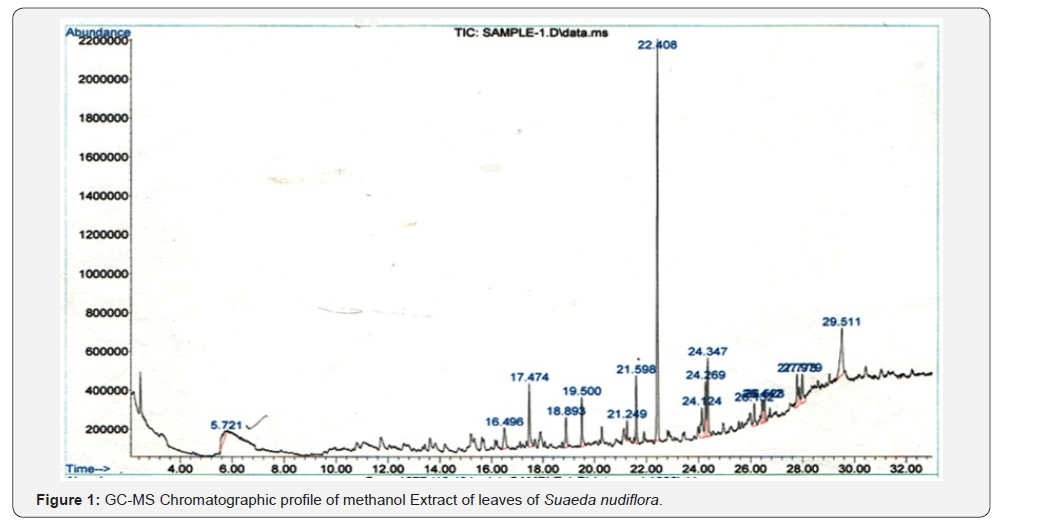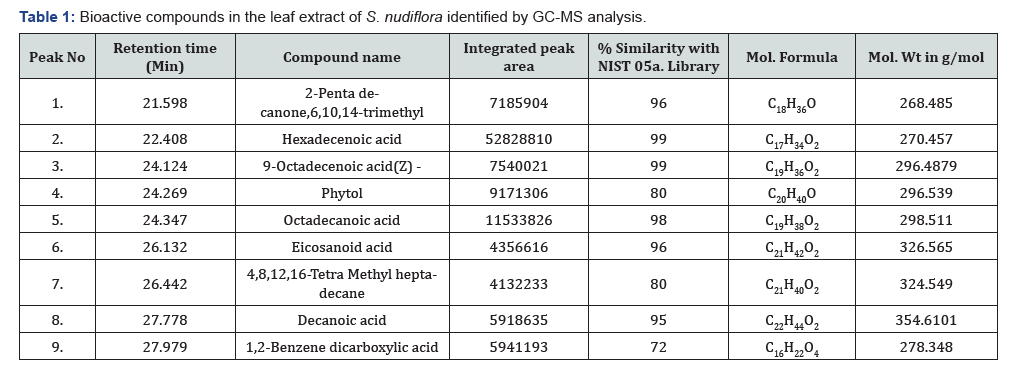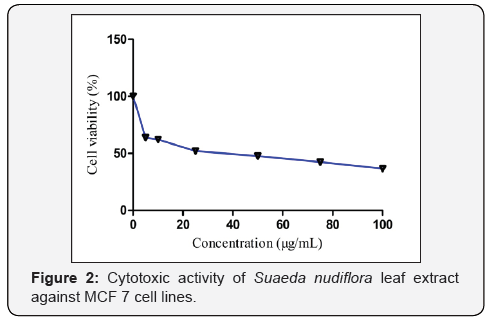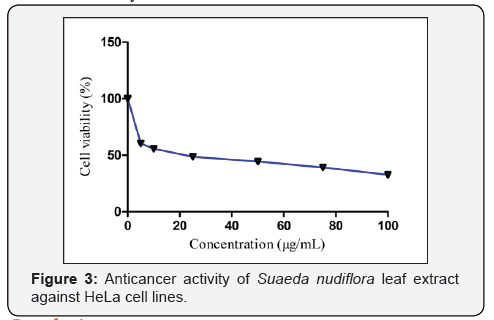GC-MS Analysis for Leaf Extract of Suaeda nudiflora and Screening of Their Invitro Antiproliferative Effect Against MCF 7 and HeLa cells
Eswaraiah G1, Venkateswarulu T C*1, Krupanidhi S1, Abraham Peele K1, Indira M1, Venkata Narayana A1, Bharath Kumar R2 and Ranga Rao A1*
1Department of Biotechnology, Vignan’s Foundation for Science, Technology & Research, India
2School of Life Sciences, Rayalaseema University, India
Submission:July 01, 2019; Published: July 26, 2019
*Corresponding author: Dr. Venkateswarulu TC, Vignan’s Foundation for Science, Technology & Research, Vadlamudi- 522213, Guntur, Andhra Pradesh, India. Dr. Ranga Rao A, Vignan’s Foundation for Science, Technology & Research, Vadlamudi- 522213, Guntur, Andhra Pradesh, India
How to cite this article: Eswaraiah G, Venkateswarulu T C, Krupanidhi S, Abraham Peele K, Indira M, et al. GC-MS Analysis for Leaf Extract of Suaeda nudiflora and Screening of Their Invitro Antiproliferative Effect Against MCF 7 and HeLa cells. Agri Res& Tech: Open Access J. 2019; 22(1): 556187. DOI: 10.19080/ARTOAJ.2019.22.556187
Abstract
In the present study, bioactive compounds from methanol leaf extracts of Suaeda nudiflora were identified by GC-MS analysis. The spectral properties of GC-MS separated compounds were found to be terpenoids, di-terpenes, phytol and fatty acids. Further, the potential of methanol extracts of S. nudiflora was screened for its anticancer activity using the cancer cell lines namely: human breast adeno carcinoma (MCF7) and human cervical cancer (HeLa). The MTT assay results revealed that cytotoxicity due to methanol extract against MCF7 and HeLa cell lines were found to be statistically significant and the viability of cell lines was reduced to 36.72 % and 32.64 % respectively. The study proved that the leaf extract of S. nudiflora was found to be more effective against HeLa cell lines in comparision with MCF 7 cell lines.
Keywords:Antiproliferative activity, Suaeda nudiflora, Methanol extracts, HeLa and MCF 7 cell lines, Acanthus illicifolia, Excoecaria agallocha, Rhizophora apiculata, Rhizophora mucronata
Introduction
The aquatic plants such as mangroves used across the river beds in coastal region for absorption of pollutants, assimilating nutrients and provide habitat for many microorganisms to decompose and maintain sufficient organic matter to support agriculture [1]. The mangrove ecosystem is associated with many microorganisms and the compounds derived from mangrove species could potentially be an important source for utilization in pharmaceutical industry [2]. Mangroves produce many natural molecules and these compounds have proved as therapeutic agents and traditionally, mangroves used in folk medicine in treatment of diseases. The chemical ingredients of the majority mangrove plants still have not been studied widely [3]. A few studies reported on mangrove plant species contain many bioactive and phytochemicals used for pharmacological purpose [4]. Most of the bioactive compounds and medicines are obtained from the roots, leaves, barks and flowers of mangrove species and they are used for treatment of different human diseases [5]. Plant derived novel bioactive and secondary metabolites are vincristine, vinblastine, etoposide, paclitaxel, camptothecin, topotecan, and irinotecan and these compounds are used in cancer treatment [6]. Many researchers reported that the leaf extracts of mangrove plant Phoenix paludosa contain bioactive compounds that have the potential activity against the cancer [7]. The bioactive compounds are also identified in the extracts of medicinally important mangrove plant, Rhizophora mucronata [8]. Mangrove plant species namely Rhizophora mucronata contain bioactive compound prenylated terpenoids having antioxidant and anticancer properties [9]. Mangrove floral species contain antioxidants and bioactive compounds which are reported to be used to treat cancer diseases [10]. The leaves of mangrove Abrus precatorius are used traditionally to treat ailments such as fever, ulcer and mouth cancer. Compounds from A. precatorius such as phenolics, terpenoids and steroids are identified by gas chromatography and these compounds are reported for anticancer activity [11]. However, till date no reports are available on anticancer ability of leaf extracts from Suaeda nudiflora. Hence, the present study is aimed to identify the bioactive compounds present in selected mangrove plant S. nudiflora and screen their ability for anticancer activity employing MSF7 and HeLa cell lines.
Materials and Methods
Sample collection and extraction of bioactive metabolites
Healthy and fresh leaf samples of Suaeda nudiflora were collected from Krishna Wildlife Sanctuary is a wildlife mangrove sanctuary located in Nizampatnam, Guntur Dist., Andhra Pradesh, India. The leaves were washed with tap water to remove dust and other organic matter on the surface of leaves and then air dried under shade at room temperature followed by grinding using pestle and motor to obtain powder. The fine 100 g powder of S.nudiflora leaf sample was mixed with 200 ml methanol and followed by extraction of bioactive compound with soxhlet apparatus for 72 hours. After completion of extraction, the solvent was distilled off and air dried to concentrate [12].
GC-MS analysis
The extract of S. nudiflora was analyzed by gas chromatography (Agilent 6890 series GC -MS) equipped with HP-5MS column (diameter length 30m; diameter 0.25mm; film thickness 0.25μm) mass spectrometer, programmed at temperature 30 °C – 280/300 °C withhold time 5 min with rate 10 °C /min. The operating condition includes, a column flow rate of 1.2ml/min, injection mode –split and helium carrier gas, 99.999%. The separated compounds in GC-MS spectra are identified based on their retention time and integral areas. The area of separated compounds are compared with the area of known compounds using NIST 5a AMDIS library search and the similarly of compounds >70% are listed [13].
MTT assay
Cytotoxicity of methanolic leaf extract with different concentrations was assessed on MCF 7 and HeLa cell lines using MTT assay by mitochondrial succinate dehydrogenase, then followed by 48 hrs incubation. Assay plates were read using spectrophotometer at 520 nm. Data generated were used to plot a dose–response curve, through which the concentration of extract required to kill 50% cell population (IC50) was determined. Calculations: % viability = (OD of test material/OD of control) x 100 and % Inhibition = 100- (% viability) [14].

Results and Discussion
GC-MS analysis
GC-MS chromatogram study showed different peaks which indicated the presence of compounds. The spectral analysis revealed that hexadecenoic acid and methyl esters are found as major compounds Figure 1. The mass spectral fingerprint of each compound identified from the standard library is represented in Table 1. The majority of compounds identified by GC-MS had previously reported and proved for different medicinally important activities. Based on the previous scientific reports, the nature of each compound and its function are listed in the Table 2. The compounds like terpenoids, diterpenes , alkaloids and fatty acid esters like 2- Penta decanone 6,10,14-trimethyl ; Hexa decanoic acid, methyl ester; Phytol; 4,8,12,16- tetramethyl heptadecane -4-olide; Docosanoic acid, methyl ester; 1,2-Benzene dicarboxylic acid are reported for anti-cancer and antioxidant activities [15- 16]. According to the studies, [17] the mangrove fern Acrostichum aureum contain different bioactive compounds and they found an important compound namely, β-sitosterol that neutralizes the proliferative changes associated with carcinogenesis and also reduces the risk from colon carcinogens.


Antiproliferative activity against MCF 7 cell lines

Cytotoxicity of the methanol leaf extract of Suaeda nudiflora against MCF 7 and HeLa cell lines are studied by MTT assay. The viability study of MCF 7 cell line clearly indicated that the viability of treated cells slowly decreased with increase of concentration of leaf extract. The percent viable cells are reduced to 36.72 at the highest concentration viz., 100 μg/ml. The graph showed cytotoxic effect of S. nudiflora leaf extract against MCF 7 cell lines Figure 2. Morphological studies proved that soon after treatment with the leaf extract, cells in culture are found reduced in size to smaller dimension and detached from the surfaces which are observed during the experimentation. The anticancer, antibacterial and antioxidant activities of the leaf extracts of mangrove species such as Acanthus illicifolia, Excoecaria agallocha, Rhizophora apiculata and Rhizophora mucronata are reported and among the selected species the Excoecaria agallocha has large number of bioactive compounds [18]. The previous studies [19] reported cytotoxicity against cancer cell lines from the extracts of Vitex trifolia L and Ipomoea pes – caprae (L) R.Br. and the extracts from these plants are rich with glycosides, phenolic acids and flavonoids. In the year [20] reported adopting MTT assay that, the leaf and root extracts of Acanthus ilicifolius showed the antimitotic effect on cancer cell lines, MCF-7 (breast cancer) and PA-1(human ovarian teratocarcinoma).
Antiproliferative activity against HeLa cell lines
The MTT assay revealed that HeLa cells viability count is reduced with the increase in the concentration of leaf extract of Suaeda nudiflora i.e., from 5μg/mL to 100μg/mL. It is apparent that the methanol extract showed significant activity even at the concentration 5μg/mL. The HeLa cells viability reduced to 32.64 % at a maximum concentration of 100μg/mL. The anticancer activity of leaf extract of S. nudiflora against the HeLa cell lines is represented in the Figure 3. For both cell lines, the cell viability data are expressed as mean + standard deviation (n = 6) and analyzed using one-way analysis of variance (ANOVA) and significant difference was noticed at p ≤ 0.05. The morphological studies confirm that after treatment with the leaf extract, experimental cell lines reduced in size to smaller and detached from the surface (Figure not shown). It was reported that the methanol extract from the Trillium govanianum rizome showed high potential in vitro cytotoxic activity against HeLa and PC 3 cell lines [21]. The findings of this study confirmed that the mangrove species are rich with therapeutic bioactive compounds that are endowed with antitumor activity

Conclusion
The present study has opened up a novel pharma research. Mangrove plants can be used for the development of potential antioxidants and anti-scavenging agents for the treatment of cancer. The presences of various bioactive compounds in S. nudiflora are identified by GC-MS. A few more of its compounds are reported to have anticancer activity. The in vitro antiproliferative ability of leaf extract of S. nudiflora is found high against HeLa cell lines than MCF 7. Further, the mangroves could be also been employed in removal of fertilizers and other nutrients namely: nitrogen and phosphorus from semi-intensive and intensive aquaculture ponds.
Conflict of interest:
The authors declare no conflict of interest
Acknowledgements
Authors would like to acknowledge the facilities supported by DST-FIST and VFSTR
References
- Wu JQ, Ruan XH, Wang X (2005) Selection and function of aquatic plants in constructed wetlands [J]. Water Resources Protection2005(1): 1-5.
- Ser HL, Palanisamy UD, Yin WF, Chan KG, Goh BH, et al. (2016) Streptomyces malaysiense sp a novel Malaysian mangrove soil actionbacterium with antioxidative activity and cytotoxic potential against human cancer cell lines. Scientific Reports 6(24247): 1-12.
- Sukhramani PS, Patel PM (2013) In vitro Biological screening of Avicennia marina for anticancer activity. Pelagia Research Library 5(5): 297-301.
- Zeng YB, Mei WL, Zhuang L, Hong K, Dai HF (2007) Cytotoxic components from mangrove plant Scyphiphora hydrophyllacea. J Trop Subtrop 15: 249-252.
- Reddy ARK, Grace J R (2016) Anticancer activity of methanolic extracts of selected mangrove plants. International journal of pharmaceutical sciences and research 7(9): 3852-3856.
- Azam K, Nur M, Rahman M, Biswas S, Ahmed M (2016) Appraisals of Bangladeshi medicinal plants used by folk medicine practitioners in the prevention and management of malignant neoplastic diseases. International Scholarly Research Notices 2016: 1-12.
- Samarakoon SR, Shanmuganathan C, Ediriweera MK, Tennekoon KH, Piyathilaka P, et al. (2016) In vitro cytotoxic and antioxidant activity of leaf extracts of mangrove plant, Phoenix paludosaTropical Journal of Pharmaceutical Research 15(1): 127-132.
- Arumugam S, Palanisamy D, Sambandam RT (2014) Identification of bioactive compounds of Rhizophora mucronata poir leaves using supercritical fluid extraction and GC-MS. World Journal of Pharmacy and Pharmaceutical Sciences 3(10): 1621-1631.
- Raola VK, Chakraborty K (2017) Two rare antioxidative prenylated terpenoids from loop-root Asiatic mangrove Rhizophora mucronata (Family Rhizophoraceae) and their activity against pro-inflammatory cyclooxygenases and lipoxidase. Natural product research 31(4): 418-427.
- Das G, Gouda S, Mohanta Y K, Patra JK (2015) Mangrove plants: A potential source for anticancer 44(5): 666-672.
- Wan-Ibrahim WS, Ismail T, Naim TN, Mohd-Salleh S F, Ismail N (2018) GC-MS Analysis of Phytochemical Compounds in Aqueous Leaf Extract of Abrus precatorius. Journal of Tropical Agricultural Science41(1): 241-250.
- Patel J (2017) Gas chromatography and mass spectroscopy analysis of bioactive components on the leaf extract of Terminalia coriacea: A potential folklore medicinal plant. International Journal of Green Pharmacy 11(1): S140-S143.
- Kulkarni, A, Govindappa M, Ramachandra YL, Koka P (2015) GC-MS analysis of methanol extract of Cassia fistula and it’s in vitro anticancer activity on human prostate cancer cell line. Indo Am J Pharm Res5(2): 937-44.
- Bhat RP (2017) Anticancer Activities of Plant Extracts of Gymnacranthera farquhariana (Hook. f. & Thomson) Warb. Myristica fatua Houtt. var. magnifica (Beddome) Sinclair and Samadera indica Adv Obes Weight Manag Control6: 167-171.
- Huang M, Lu JJ, Huang MQ, Bao JL, Chen XP, et al. (2012) Terpenoids: natural products for cancer therapy. Expert Opin Investig Drugs21(12): 1801-1818.
- Wannes WA, Tounsi MS, Marzouk BA (2017) Review of tunisian medicinal plants with anticancer activity. J Complement Integr Med 15(1): 35.
- Thomas A, Peter PK J, Chandra mohana kumar N (2016) A profiling of anti-tumor potential of sterols in the mangrove fern Acrostichumaureum. Int J Pharmacognosy and Phytochem Res 8(11): 1828-1832.
- Satyavani K, Gurudeeban S, Manigandan V, Rajamanickam E, Ramanathan T (2015) Chemical compositions of medicinal mangrove species Acanthus ilicifolius, Excoecaria agallocha, Rhizophora apiculata and Rhizophora mucronata. Curr Res Chem 7(1): 1-8.
- Chan EWC, Baba S, Chan HT, Kainuma M, Tangah J (2016) Medicinal plants of sandy shores: A short review on Vitex trifolia and Ipomoea pes-caprae (L.) R. Br IJNPR 7(2): 107-115.
- Smitha RB, Madhusoodanan PV, Prakashkumar R (2014) Anticancer activity of Acanthus illicifoliuslinn. From chettuva mangroves, Kerala, India. International Journal of Bioassays 3(11): 3452-3455
- Rahman S, Ismail M, Shah M, Iriti M, Shahid M (2015) GC/MS analysis, free radical scavenging, anticancer and β-glucuronidase inhibitory activities of Trillium govanianum Bangladesh Journal of Pharmacology 10(3): 577-583.






























